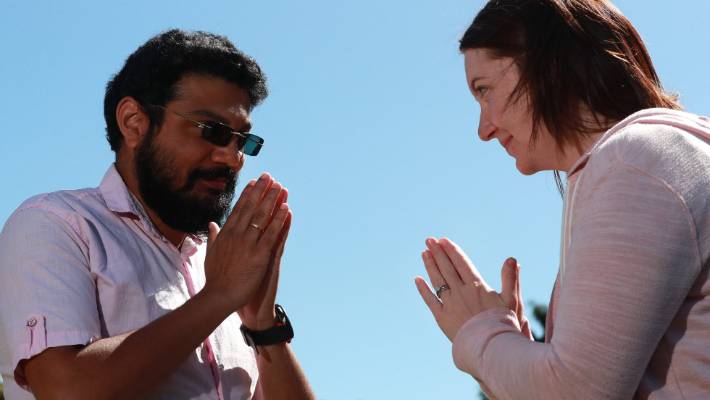In America, what’s a common way for a person to greet someone? A usual “Hi! Nice to meet you!” followed by a handshake is what many would think of when asked that question. What started as a Greek symbol of peace has became an everyday action now, but how do you feel about the new elbow bump that’s becoming commonplace with social distancing?
With COVID-19 still a concern, you may be wary of exchanging physical contact. So instead of the usual universal greeting, why not take a look at how other cultures greet each other? Though the handshake has been a long tradition in American life, learning and trying out different new ways to greet people can be a fun, unique experience, while also helping you build stronger bonds with people from various backgrounds. It may even come in handy on your next business or leisure trip!
1. Bow

photo courtesy of TripSavvy
In Eastern Asian countries like Japan and Korea, bowing is a common greeting. Though everyone greets by bowing, the meaning of the gesture can take on different forms. It can symbolize respect, sincerity, humility, and remorse, depending on the context of the situation. Increase the emotion behind the greeting by bowing lower than the other person.
For a Japanese bow or “ojigi,” men should have their hands to their sides, while women would place their hands onto their laps. During the bow, make sure to lower your gaze and avoid eye contact. The neck and back should be a straight line. In informal situations, a 15-degree angle bow is acceptable, but during formal situations, a 30-degree angle bow is expected. In Korea, however, numerous bows or “konsu” are practiced. They vary from casual and respectful, to “belly-button” bows. Each gesture has different guidelines to follow for specific settings a person may be in.
Check out this video for a more in-depth explanation and the difference between the two cultural bows!


2. Shaking Fist

Photo courtesy by Mental Floss
This greeting of shaking your own fist in the air is common among the Kanuri tribe in Niger. The Kanuri tribe belongs to the Saharan Branch of the Nilo-Sharan, and its lineage traces back to the medieval Kanem-Bornu Empire. As farmers, fishers and traders, it’s common to encounter the Kanuri people in Southeast Niger. Instead of smiling or waving, shaking fists is a formal greeting!
To correctly do this, raise your hands at eye level and then form them into fists. Then, shake your fists while saying “wooshay!” which translates to “hi!”
3. Wai

Photo courtesy by Koh Samui Sunset
The wai, pronounced “why,” is exclusive to the people of Thailand. The wai complements the Thai word “sawasdee” which means hello. However, it’s recommended to not gesture the wai to people who are younger than you, as age plays a major role in social ranking in Thailand. Instead, give them a nod and smile. Use the greeting to say goodbye, to apologize, and to pay respects to spirit houses, temples or shrines!
To wai, place your palms together with each finger touching its counterpart. With your hands at the center of your chest, bend your neck toward your fingers. As your neck is lowering, rotate your hands to where your index figure will touch your nose. The higher you place your hands, the more respect is conveyed.
4. Tongue Out

Photo courtesy of Home Exchange
Across the globe, children often stick their tongues out when making fun of each other. As adults, we refrain from this as it is considered rude. In Tibet, however, it’s quite the opposite, and is actually a formal greeting. The tradition stems from the 9th century during the rule of Tibetan King Lang Darma. Known for his cruelty and black tongue, Darma is an infamous figure in Tibetian history.
Tibetans fear Darma’s incarnation and stick out their tongues as a greeting. If the tongue is not black, they are deemed not guilty of evil deeds, and are not incarnations of the malevolent king. When you visit Tibet, you don’t have to worry about being impolite since the greeting is actually a form of respect!
5. Namaste

Photo courtesy of Stuff
During this time of social distancing, namaste has become the go-to method across the globe for greeting people. The action is a customary, non-contact form of Hindu greeting predominately found in India. The meaning behind the custom is to welcome guests, relatives, or to acknowledge strangers. It expresses courtesy, politeness and gratitude, while also acting as a salutation and valediction. Derived from the Sanskrit language and meaning, “I bow to the divine in you,” namaste is the highest and most respectful greeting in the world!
To say namaste, hold both palms together with forefingers posing upwards. Bring your thumbs close to your chest. Close your eyes as you bow, and say “namaste” loud and clear. For an example of how to correctly observe this greeting, watch this video from Hemalayaa.
~By Virtual Marketing & Communications Intern, Laura Vo. Laura’s a Public Relations Major at Kennesaw State University and has a passion for supporting great causes like Go Eat Give.